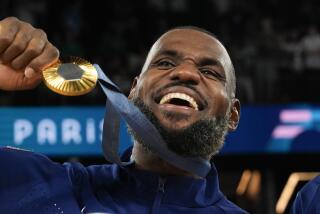U.S. Bid on Track in Bobsled, Luge : Preview: Walker provides a powerful ‘motor,’ but tricky La Plagne demands skilled driving.
- Share via
For the first time at the Winter Olympics, there actually might be a link between the bobsled and luge, and it isn’t the fact that in both sports you happen to slide down an icy track in a sawed-off bathtub wearing a rubber suit, helmet and funny boots.
No, it’s something completely different. The United States has a shot at winning a medal in both events, which hasn’t happened since 1956 in the bobsled and hasn’t happened at all in luge. Part of the reason for such optimism is the presence of Minnesota Viking running back Herschel Walker, who is the pusher for the top two-man and four-man U.S. bobsleds.
BOBSLED
Why would a football star tackle a sport such as bobsledding? Maybe this is what we should expect from a player who has already tried ballet and taekwondo, written poetry and trained with the FBI. If this sounds like a bizarre resume, it ought to prepare Walker for the intrigue that goes hand-in-glove with the U.S. bobsled federation.
The U.S. bobsled federation hopes Walker’s exploits can erase the embarrassing side of its image, created when the governing board resigned amid allegations of fiscal improprieties. The embarrassment continued with the suspension of its replacement president and a blizzard of lawsuits, restraining orders and hearings.
Walker should make an immediate impact, said Liston Bochette, a driver on Puerto Rico’s bobsled team.
“It’s a spotlight event now,” Bochette said. “The U.S. has the best ‘motor’ in the business, no doubt. I’m sure Germany, Switzerland or Austria would love to have a motor like Herschel Walker.”
Because of Walker, the U.S. emphasis is on power, and that may prove to be a disadvantage. The Olympic bobsled course at La Plagne is not a traditional track and is generally regarded as difficult. Unlike the 14-turn track at Calgary during the 1988 Winter Games, the La Plagne track has 19 turns, which places a premium on driver skill instead of power. Randy Will and Brian Shimer are expected to drive the top two-man and four-man U.S. sleds.
The team with the lowest aggregate time after four runs wins.
OUTLOOK
Wolfgang Hoppe of Germany is regarded as the top driver in the world and probably will contend with Swiss driver Gustav Weder for the gold medals in the two-man and four-man bobsleds.
Russia, which won the gold in the four-man at Calgary, might not be a factor this time because of the breakup of the Soviet Union. Latvia, which will field its own team, is where most of the top Russian drivers have come from, including 1988 two-man gold-medal driver Janis Kipours.
The United States, which finished fourth in the four-man bobsled in Calgary, must hope the German, Swiss and Austrians have an off day.
LUGE
American medal hopes in the luge hinge on 24-year-old free spirit Duncan Kennedy of Santa Cruz. Kennedy, who took the 1989-90 luge season off, returned in 1991 and got back on the right track. He finished seventh in the World Championships--the best finish by a U.S. man.
Kennedy celebrated by attending a Dread Zeppelin concert, where he passed out luge literature to the band.
“They were really psyched,” Kennedy told Outside magazine, a publication for outdoor enthusiasts.
And now the United States is similarly psyched. Joining Kennedy as a potential medal-winner is 23-year-old Cammy Myler, who was ninth at Calgary and ninth in the World Championships at Winterburgen, Germany. Bonny Warner, 29, sixth at Calgary, is probably a longshot.
The luge sleds often reach top speeds of 80 m.p.h. and are guided by foot movements of the competitor, who lies atop the sled as it hurtles down the icy, 1,200-meter long track on sharp, thin blades. It is the only Olympic sport timed to one-thousandth of a second.
There is one rule change this year: the toe-pointer that bound the sledders’ feet inward has been outlawed, which means that competitors must be able to walk from the track under their own power or be disqualified.
In singles, the team with the lowest aggregate time after four runs wins. If a luger crashes and is unable to complete the run, the sledder is disqualified from all future runs. In men’s doubles, the sled with the lowest aggregate time is the winner.
OUTLOOK
Kennedy, a gold-medal contender in men’s singles, has two golds, two silvers and a bronze medal in five starts on the World Cup luge circuit.
Besides Kennedy and 1988 gold medalist Jens Muller, other favorites for the gold are Markus Prock of Austria and Georg Hackl of Germany. In the women’s singles event, Myler will have to challenge Susi Erdmann of Germany and Gabrielle Kohlisch of Germany, among others.
Austrian and German sledders have won 18 of the 21 gold medals since luge was introduced to the Winter Olympics in 1964. There is no women’s competition in doubles, and the U.S. men are not expected to challenge for a medal in the two-man event.
More to Read
Go beyond the scoreboard
Get the latest on L.A.'s teams in the daily Sports Report newsletter.
You may occasionally receive promotional content from the Los Angeles Times.






